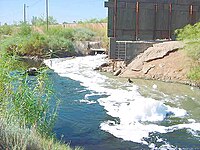
Fate and effects of sediment-associated triclosan in subtropical freshwater microcosms.
Sign Up to like & getrecommendations! Published in 2018 at "Aquatic toxicology"
DOI: 10.1016/j.aquatox.2018.07.008
Abstract: Triclosan (TCS) is an antibacterial agent that is commonly used in personal care products. Because of its sediment-binding properties, TCS exposure presents a potential threat to sediment-dwelling aquatic organisms. Currently our knowledge of the fate… read more here.
Keywords: freshwater; fate effects; sediment; tcs ... See more keywords

Exploring the impacts of heavy metals on spatial variations of sediment-associated bacterial communities.
Sign Up to like & getrecommendations! Published in 2020 at "Ecotoxicology and environmental safety"
DOI: 10.1016/j.ecoenv.2020.111808
Abstract: One of the fundamental objectives in modern ecology is to decipher how bacterial communities in natural environment respond to anthropogenic activities. In recent times consequences of marine pollution, especially with heavy metals (HMs) have received… read more here.
Keywords: bacterial communities; contaminated area; significantly contaminated; heavy metals ... See more keywords

The Antitumor Antibiotics Complex of Aureolic Acids from the Marine Sediment-associated Strain of Streptomyces sp. KMM 9048
Sign Up to like & getrecommendations! Published in 2017 at "Natural Product Communications"
DOI: 10.1177/1934578x1701200427
Abstract: A new antibiotic complex of six aureolic acids was isolated from the marine sediment-associated strain Streptomyces sp. KMM 9048. Four of the compounds (3–6) were found to be similar but not identical to the known… read more here.
Keywords: streptomyces kmm; aureolic acids; associated strain; strain streptomyces ... See more keywords

Integrated assessment of biomarker responses and comparative toxicity pathway in snails Bellamya aeruginosa exposed to tributyltin and triphenyltin in sediments
Sign Up to like & getrecommendations! Published in 2020 at "Environmental Sciences Europe"
DOI: 10.1186/s12302-020-00373-y
Abstract: Sediments function as a secondary and significant source of tributyltin (TBT) and triphenyltin (TPT) in aquatic ecosystems and may pose a potential threat on benthic organisms and human health. The subchronic toxicity of sediment-associated TBT… read more here.
Keywords: triphenyltin; toxicity; tributyltin; tbt tpt ... See more keywords